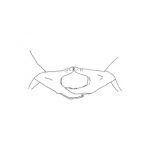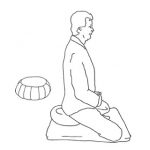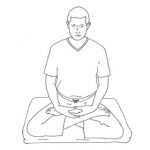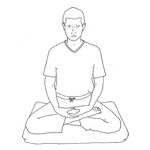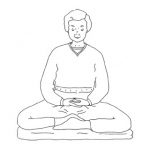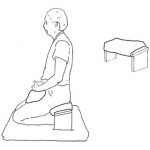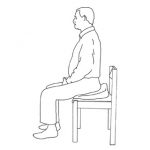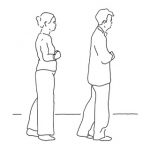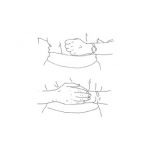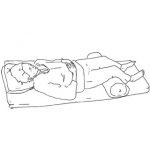 The means of training are thousandfold,
The means of training are thousandfold,
but pure meditation must be done.
Dogen Rules for Meditation
The purpose of Serene Reflection (Soto Zen) Meditation is to come to know and live from the Unborn, the Buddha Nature within ourselves and all things. All of us have an intuitive knowledge of the Buddha Nature, therefore meditation is not a means to an end but rather a harmonization of oneself with the source of compassion, love and wisdom. Meditation is the foundation of Buddhist religious practice.
Meditate in a quiet, well-ventilated room. The room should be neither too bright nor too dark. Wear clean clothing that does not restrict the waist or the legs. Find the most stable position for you, sitting on a chair or meditation bench. If you are extremely flexible you can use a meditation cushion, sitting in the cross-legged position either full or half lotus. Sit on the forward third of the cushion and with each meditation period alternate the leg you place on top. Do not persist in using a meditation cushion if you find the position painful. (See the illustrations below showing various meditation positions.)
To center yourself, sway the body gently from left to right and backwards and forwards. Allow the two natural curves of the spine to form at the neck and small of the back. The head should be held upright, its weight balanced on the shoulders and the chin slightly tucked in. The tongue is held lightly against the back of the top teeth with the lips and teeth closed. Breathe normally.
Rest the right hand in the lap with the left hand in the palm of the right hand (some left-handed people find it useful to do the reverse). The tips of the thumbs touch lightly and form an oval. Keep the eyes open and lowered, allowing the gaze to fall gently on the wall or floor in front of you. Keep the eyes in focus but do not stare. If you wear glasses, leave them on.
Slowly take two or three breaths through the nose, follow the breath up the back on inhalation and down the front of the body on exhalation, thus describing a circle. Then breathe normally for you. Sit steadily with an alert and bright mind, neither suppressing nor indulging thoughts that may arise. Allow thoughts and sensations to arise and pass naturally, but do not engage in deliberate thought. When the mind wanders, just notice and bring yourself back to being still and mindful. You can use the circular breathing pattern described to help you achieve this. Sitting still with no deliberate thought is the important aspect of Serene Reflection meditation.
Meditate regularly, every day if possible, if only for a few minutes. Mornings and evenings or a quiet time in your schedule are best. Do not meditate in the formal positions directly after meals, or when physically exhausted, or in extremes of temperature. It is good to meditate for a specific length of time and stick to it, be it five, ten, or thirty minutes. Do not exceed forty-five minutes at one sitting period without walking meditation or relaxing the body for at least ten minutes. Meditating with a group can be very helpful.
ILLUSTRATIONS OF MEDITATION POSITIONS
From Sitting Buddha with permission of Rev. Master Daishin Morgan.
- Hand Position Seated Meditation
- Using Cushion
- Full Lotus
- Half Lotus
- Burmese Position
- Using Bench
- Using Chair
- Walking Meditation
- Hand Positions Walking Meditation
- Lying Down
AUDIO DHARMA TALKS AND VIDEOS ON MEDITATION
Video of Serene Reflection Meditation Instruction: Part 1A Rev. Master Margaret Clyde and Rev. Allard Kieres 2-20-21 32 min
Video of Serene Reflection Meditation Instruction: Part 1B Rev. Master Oswin Hollenbeck 2-20-21 21 min
Serene Reflection Meditation Rev. Master Meian Elbert 07-26-12 29 min/10 MB
The Art of Meditation Rev. Master Jiyu-Kennett 1978 67 min/23 MB
The Treasury of Radiant Light In Our Own Hearts Rev. Vivian Gruenenfeder 07-28-12 30 min/10 MB
Meditation and Practice: Our Great Wish Rev. Astor Douglas 05-01-11 30 min/10 MB
Zen Meditation Videos Videos taken from the DVD which were produced at Throssel Hole Buddhist Abbey in England in 2006 are available in four chapters: 1) What is Meditation? 2) Posture, 3) The Mind of Meditation, and 4) Meditation in Action. It features monks and lay trainees from Throssel Hole and the Reading Buddhist Priory Sanghas explaining what is involved in beginning and maintaining a practice of serene reflection meditation.
WRITTEN TEACHINGS ON MEDITATION
Rules for Meditation by Great Master Dogen
Physical Postures for Meditation by Rev. Master Daishin Morgan
How to Sit by Rev. Master Jiyu-Kennett
Spiritual Simplicity by Rev. Master Daizui MacPhillamy
Applying Meditation to Everyday Life by Rev. Master Jisho Perry
Children and Meditation by Rev. Master Jiyu-Kennett
Every MInute Meditation by Rev. Master Daizui MacPhillamy
The Mind of Meditation by Rev. Master Daishin Morgan

